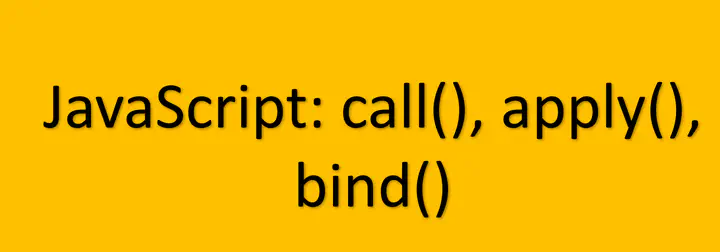Javascript all(),bind(),apply()

Javascript all(),bind(),apply() 方法介绍
- 下面简化程序不work:
var abc = {
sendmail: function () {
console.log("sendmail")
},
get: function () {
console.log("get")
this.sendmail();
},
}
setInterval(abc.get, 1000);
输出结果:
this.sendmail();
^
TypeError: this.sendmail is not a function
- 正确修改方法是:setInterval(abc.get.bind(abc), 1000); 为什么需要bind呢? 今天重温Javascript中call(), apply() 和 bind()函数是什么意思? 首先查看Javascript 函数属性有哪些?
interface Function {
/**
* Calls the function, substituting the specified object for the this value of the function, and the specified array for the arguments of the function.
* @param thisArg The object to be used as the this object.
* @param argArray A set of arguments to be passed to the function.
*/
apply(this: Function, thisArg: any, argArray?: any): any;
/**
* Calls a method of an object, substituting another object for the current object.
* @param thisArg The object to be used as the current object.
* @param argArray A list of arguments to be passed to the method.
*/
call(this: Function, thisArg: any, ...argArray: any[]): any;
/**
* For a given function, creates a bound function that has the same body as the original function.
* The this object of the bound function is associated with the specified object, and has the specified initial parameters.
* @param thisArg An object to which the this keyword can refer inside the new function.
* @param argArray A list of arguments to be passed to the new function.
*/
bind(this: Function, thisArg: any, ...argArray: any[]): any;
/** Returns a string representation of a function. */
toString(): string;
prototype: any;
readonly length: number;
// Non-standard extensions
arguments: any;
caller: Function;
}
- 具体细节我就不再讲述了,代码有注释。举个例子说明吧: 先看下bind函数,官方文档说:该bind()方法创建了一个新函数,在调用时,其this关键字设置为提供的值。这是非常强大的。它让我们明确定义this调用函数时的值。让我们分解一下。当我们使用该bind()方法时:JS 引擎正在创建一个新pokemonName实例并将pokemon其绑定为它的this变量。理解它复制 pokemonName 函数很重要。创建pokemonName函数的副本后,它可以调用logPokemon(),尽管它最初不在 pokemon 对象上。它现在将识别其属性(Pika and Chu)及其方法。很酷的事情是,在我们 bind() 一个值之后,我们可以像使用任何其他普通函数一样使用该函数。我们甚至可以更新函数以接受参数,传递它们.
var pokemon = {
firstname: 'Pika',
lastname: 'Chu ',
getPokeName: function() {
var fullname = this.firstname + ' ' + this.lastname;
return fullname;
}
};
var pokemonName = function() {
console.log(this.getPokeName() + 'I choose you!');
};
var logPokemon = pokemonName.bind(pokemon); // creates new object and binds pokemon. 'this' of pokemon === pokemon now
logPokemon(); // 'Pika Chu I choose you!'
call(), apply()方法,call() 的官方文档说:该call()方法调用具有给定this值和单独提供的参数的函数。这意味着我们可以调用任何函数,并明确指定在调用函数中this应该引用什么。与bind()方法真的很像!bind()和call()主要区别在于call()方法接受额外的参数,立即执行它被调用的函数,call() 方法不会复制正在调用它的函数。call()并apply()服务于完全相同目的。它们工作方式的唯一区别是call() 期望所有参数单独传入,而 apply() 期望我们所有参数的数组。请注意,apply 接受数组,并且 call期望转递每个参数。
var pokemon = {
firstname: 'Pika',
lastname: 'Chu ',
getPokeName: function() {
var fullname = this.firstname + ' ' + this.lastname;
return fullname;
}
};
var pokemonName = function(snack, hobby) {
console.log(this.getPokeName() + ' loves ' + snack + ' and ' + hobby);
};
pokemonName.call(pokemon,'sushi', 'algorithms'); // Pika Chu loves sushi and algorithms
pokemonName.apply(pokemon,['sushi', 'algorithms']); // Pika Chu loves sushi and algorithms
这些存在于每个 JS 函数中的内置方法非常有用。即使您最终没有在日常编程中使用它们,您在阅读其他人的代码时仍然会经常遇到它们。
参考文档
[1] mozilla.org
[2] medium.com